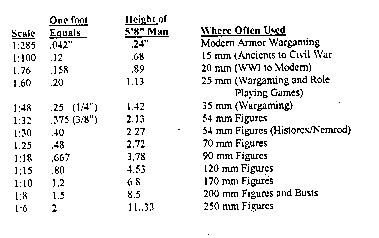 |
TIPS |
 |
TIPS |
MORE ON SCALES
Those who wish to use figures and parts from commercial kits, miniature railroad accessories, wargaming supplies, and other sources may want to consult these notes.Wargaming and Miniature Figurines
Naval wargaming scales are usually 1:2400 and 1:1200. There are several manufacturers of superbly detailed men of war, dreadnoughts and carriers. These waterline models are cast in white metal (sometimes resin) and can be assembled and painted in a matter of hours. Modern armor battles are usually played with 1:285 scale tanks. 1:285 troop figures are available, but they tend to look like little lead blobs.
Wargaming figures are traditionally grouped according to height in millimeters. However, there can be a wide variation in scale within a single category. For instance, one manufacturer might consider 15 mm to be the height of an average man, while another includes the headgear in their measurements. Many "25 mm" figures are actually much larger than claimed, especially those used in fantasy role-playing games. This is also somewhat true for the larger display figurines (about 54 mm and up). Thus, while 54 mm is considered analogous to 1:32, Historex and its associated company Nemrod claim that their lines of Napoleonic soldiers are actually 1:30 scale.
With that in mind, consider the table at right as "ballpark" estimates and be
sure to check an individual figure to see whether its size is appropriate for your model.
The smaller figures are almost always cast in white metal (older ones were primarily
lead), but the larger statuettes might also be in resin, vinyl, or porcelain. Modifying
and painting these figures is an art form in itself.
consider the table at right as "ballpark" estimates and be
sure to check an individual figure to see whether its size is appropriate for your model.
The smaller figures are almost always cast in white metal (older ones were primarily
lead), but the larger statuettes might also be in resin, vinyl, or porcelain. Modifying
and painting these figures is an art form in itself.
Architectural Model Scales
Depending on the project, rough conceptual models can be in 1:2500, 1:1000, 1:500, 1:200, 1:100, or 1:50 scales. Presentation models of small buildings (like single family residences) are usually in 1:48 scale. Plastruct and Evergreen both provide a wide range of plastic sheets, as well as fences, stairs, ladders, siding, railings, shingles, and tread plates in the common railroading scales (HO, O, N, and G). Figures are also made for architectural models, but since they are only meant to provide some human comparison to the building, they normally lack detail.